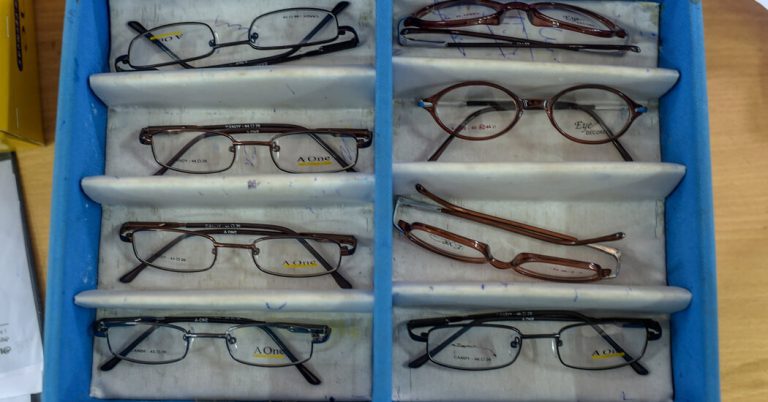If you’re 50 or older and reading this article, chances are you’re wearing a pair of inexpensive reading glasses to correct your presbyopia or farsightedness, the age-related decline in vision that makes it progressively harder to see fine details letters and tiny objects.
Eventually, everyone gets the condition.
But for nearly a billion people in the developing world, reading glasses are a luxury that many cannot afford. According to the World Health Organization, lack of access to corrective glasses hinders learning among young students, increases the likelihood of road accidents and forces millions of middle-aged factory workers and farmers to leave the workforce too early.
Uncorrected presbyopia, not surprisingly, makes it harder for breadwinners to support their families. That’s the conclusion of a new study which found that garment workers, artisans and tailors in Bangladesh who were given free reading glasses saw a 33% increase in income compared to those who were not given glasses.
The study, published Wednesday in the journal PLOS One, included more than 800 adults in rural Bangladesh, many of whom work in jobs that require intense attention to detail. Half of the participants — a mix of tea makers, weavers and seamstresses between the ages of 35 and 65 — were randomly selected to receive a free pair of reading glasses. The others were not given glasses.
The researchers followed up eight months later and found that the group with glasses had shown a significant increase in income, receiving an average monthly income of $47.10, compared to $35.30 for participants without glasses.
The study subjects were evenly split between men and women, and just over a third were literate.
Dr Nathan Congdon, lead author of the study and an ophthalmologist at Queen’s University Belfast in Northern Ireland, said the results added to a growing body of evidence quantifying the economic impact of uncorrected vision in parts of the world where it costs about $1.50 to buy a couple of so-called readers are out of reach for many.
“All of us would be happy with a 33 percent jump in income,” said Dr. Congdon, who specializes in low-cost eye care delivery models. “But what makes the results particularly exciting is the potential to convince governments that vision care interventions are just as cheap, cost-effective and life-changing as anything else we can offer in healthcare.”
Dr. David S. Friedman, professor of ophthalmology at Harvard Medical School, who was not involved in the study, said he was impressed by the results and hopes future studies will confirm the findings. “These economic impacts are large, real and could have a substantial impact on people’s lives,” he said.
Eye care has long been the neglected stepchild of public health in the developing world. infectious diseases such as tuberculosis, malaria and AIDS tend to attract stronger government and philanthropic support. However, visual impairment is a serious global issue, with a projected cost of more than $400 billion in lost productivity, according to the WHO
Experts say spending on eye care can have a significant impact on communities, both in terms of increased economic returns and improved quality of life. Compared to other, more intractable health problems, treating presbyopia is quite inexpensive. The glasses can often be produced for less than $2 a pair, and the fittings are usually made by community workers who can be trained in as little as a day.
Misha Mahjabeen, Bangladesh director for VisionSpring, a non-profit organization involved in the study, said a lack of resources was only one obstacle to increased distribution of reading glasses. In many Bangladeshi villages, she said, community workers must deal with the social stigma attached to wearing glasses, especially for women.
Overall, the health needs of women in Bangladesh are second only to those of men. “In our male-dominated society, when a man has a problem, it requires immediate attention, but women can wait,” she said.
But the effects of vision loss can be particularly severe for women, who are often responsible for earning extra income for their families in addition to childcare and housework, Ms Mahjabeen said. “When it takes more time to sew and clean, or you can’t separate all the stones from the rice, in some households it leads to domestic violence,” he said.
VisionSpring distributes more than two million pairs of glasses annually across South Asia and Africa, up from 300,000 in 2018.
The study in PLOS One builds on previous research involving tea pickers in India, which found a significant jump in productivity among study participants given reading glasses. The work, a randomized study published in The Lancet Global Health in 2018, recorded a 22 percent increase in productivity among workers given glasses. For those over 50, productivity increased by nearly 32 percent.
Agad Ali, 57, a Bangladeshi tailor in the town of Manikganj, was among those who received a pair of glasses as part of the study published this week. In an interview conducted by a community health worker and sent via email, she described how worsening presbyopia had made it increasingly difficult to thread needles and sew clothes, adding to the time it took to finish each sewing work. Over time, he said, some customers went elsewhere and his income began to decline. “It made me feel very helpless,” she said.
Since receiving the glasses, he said, his income has doubled. “These glasses are like my lifeline,” he told the community health worker. “I couldn’t do my job without them.”




